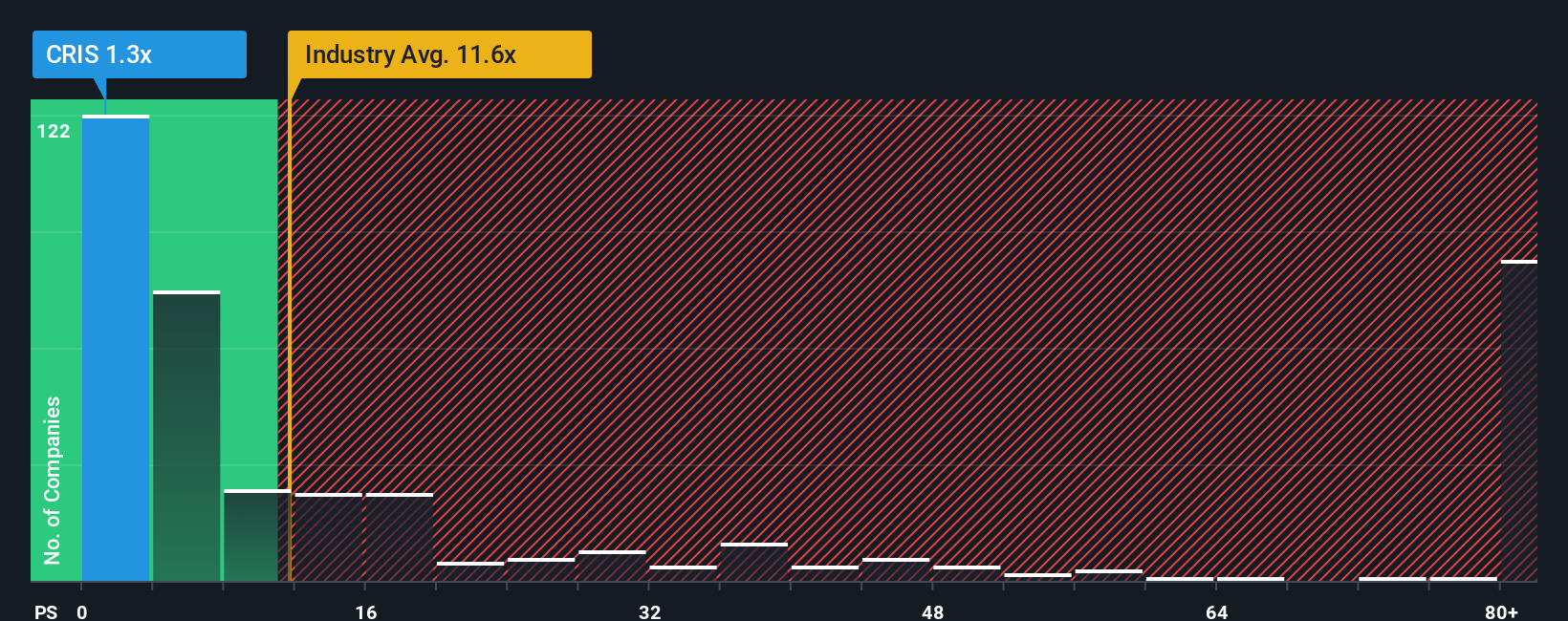- United States
- /
- Biotech
- /
- NasdaqCM:CRIS
Curis, Inc. (NASDAQ:CRIS) Looks Inexpensive After Falling 28% But Perhaps Not Attractive Enough
The Curis, Inc. (NASDAQ:CRIS) share price has fared very poorly over the last month, falling by a substantial 28%. For any long-term shareholders, the last month ends a year to forget by locking in a 69% share price decline.
Following the heavy fall in price, Curis' price-to-sales (or "P/S") ratio of 1.3x might make it look like a strong buy right now compared to the wider Biotechs industry in the United States, where around half of the companies have P/S ratios above 11.6x and even P/S above 100x are quite common. Nonetheless, we'd need to dig a little deeper to determine if there is a rational basis for the highly reduced P/S.
See our latest analysis for Curis

How Curis Has Been Performing
Curis could be doing better as it's been growing revenue less than most other companies lately. The P/S ratio is probably low because investors think this lacklustre revenue performance isn't going to get any better. If you still like the company, you'd be hoping revenue doesn't get any worse and that you could pick up some stock while it's out of favour.
Want the full picture on analyst estimates for the company? Then our free report on Curis will help you uncover what's on the horizon.What Are Revenue Growth Metrics Telling Us About The Low P/S?
Curis' P/S ratio would be typical for a company that's expected to deliver very poor growth or even falling revenue, and importantly, perform much worse than the industry.
Taking a look back first, we see that the company managed to grow revenues by a handy 14% last year. The latest three year period has also seen a 12% overall rise in revenue, aided somewhat by its short-term performance. So we can start by confirming that the company has actually done a good job of growing revenue over that time.
Turning to the outlook, the next three years should generate growth of 51% per year as estimated by the five analysts watching the company. With the industry predicted to deliver 124% growth per year, the company is positioned for a weaker revenue result.
In light of this, it's understandable that Curis' P/S sits below the majority of other companies. It seems most investors are expecting to see limited future growth and are only willing to pay a reduced amount for the stock.
The Bottom Line On Curis' P/S
Curis' P/S looks about as weak as its stock price lately. Typically, we'd caution against reading too much into price-to-sales ratios when settling on investment decisions, though it can reveal plenty about what other market participants think about the company.
We've established that Curis maintains its low P/S on the weakness of its forecast growth being lower than the wider industry, as expected. At this stage investors feel the potential for an improvement in revenue isn't great enough to justify a higher P/S ratio. It's hard to see the share price rising strongly in the near future under these circumstances.
It's always necessary to consider the ever-present spectre of investment risk. We've identified 5 warning signs with Curis (at least 3 which are a bit concerning), and understanding these should be part of your investment process.
If these risks are making you reconsider your opinion on Curis, explore our interactive list of high quality stocks to get an idea of what else is out there.
New: AI Stock Screener & Alerts
Our new AI Stock Screener scans the market every day to uncover opportunities.
• Dividend Powerhouses (3%+ Yield)
• Undervalued Small Caps with Insider Buying
• High growth Tech and AI Companies
Or build your own from over 50 metrics.
Have feedback on this article? Concerned about the content? Get in touch with us directly. Alternatively, email editorial-team (at) simplywallst.com.
This article by Simply Wall St is general in nature. We provide commentary based on historical data and analyst forecasts only using an unbiased methodology and our articles are not intended to be financial advice. It does not constitute a recommendation to buy or sell any stock, and does not take account of your objectives, or your financial situation. We aim to bring you long-term focused analysis driven by fundamental data. Note that our analysis may not factor in the latest price-sensitive company announcements or qualitative material. Simply Wall St has no position in any stocks mentioned.
About NasdaqCM:CRIS
Curis
A biotechnology company, engages in the discovery and development of drug candidates for the treatment of human cancers in the United States.
Moderate risk and slightly overvalued.
Similar Companies
Market Insights
Community Narratives



